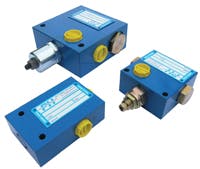Exchange valves for hydrostatic transmissions
VE10, VE30 and VE60 exchange valves are used for bleeding hot oil from the low-pressure side of a hydrostatic transmission circuit. The hot oil can be cooled, filtered, or used as a source of oil for flushing another pump and motor case. The valves are suitable for exchange flows from 10 to 60 lpm at pressure to 450 bar. Exchange pressure can be adjusted between 12 and 30 bar using VE30 and VE60 versions. The cooled oil can regulate the temperature of the hydraulic circuit. Compact size allows easy integration into all types of hydraulic circuits.
Poclain Hydraulics Inc.
(262) 321-0688
www.poclain-hydraulics.com


